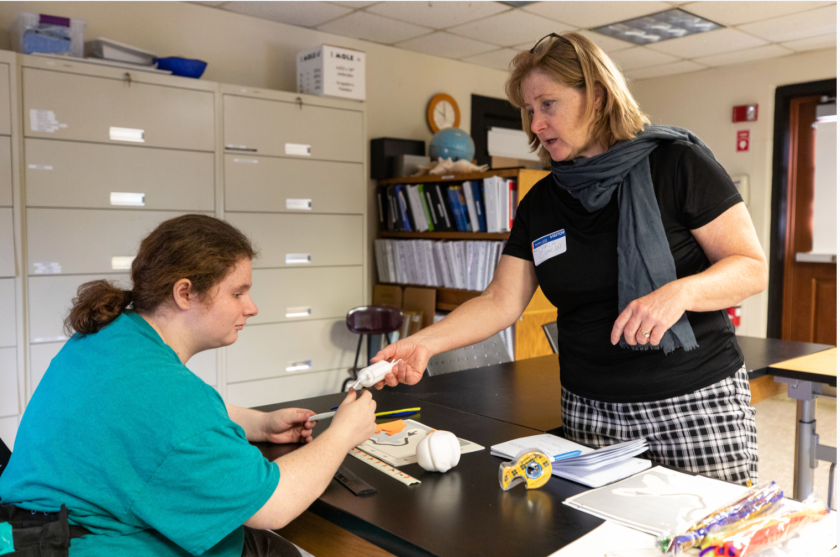
Dr. Carla Curran works with a student at Perkins School for the Blind in Watertown, Massachusetts.Michael Brook/Courtesy of Perkins School for the Blind
Welcome to Recharge, a weekly newsletter full of stories that will energize your inner hellraiser. See more editions and sign up here.
The students can’t see the 3D models of microscopic marine life, but they can feel them, graph them, and make groundbreaking discoveries about them. It’s one of the latest ways teachers are bringing blind and partially sighted students more fully into the world of science.
Many of the students “heard things that I didn’t hear,” says Amy Bower, an oceanographer who assists them. “As a visually impaired scientist myself, I know how quickly blind students can be left out altogether in school science labs.” Learning science “through other senses means you don’t have to rely solely on vision,” says Izzy Primeau, a recent graduate of the program at Perkins School for the Blind outside Boston. Primeau, who lost part of her vision, says the confidence she learned at Perkins has driven her to study animal care after graduation. Students have ventured out to hear whales and touch marine creatures in saltwater tanks, the Christian Science Monitor reports, and they’ve detected patterns in ocean currents and fluctuating fish populations by listening to audio recordings of numerical charts.
“Science uses sound to study the ocean,” says marine science professor Carla Curran, a guest educator at the program. The hands-on classwork and field trips to the ocean “bring science alive for all students, sighted or not,” Bower says.
Here are more Recharge stories to get you through the week:
Toronto’s secret sauce. With the multiplying effects of climate change, “we need a way to get people out of their cars faster than we can rebuild the suburbs where most people live,” writes urban planning doctoral candidate Jonathan English. Canada’s biggest city has developed a suburban bus system that’s the envy of most US cities. Buses stop every 10 minutes until late at night, three times as frequent as the busiest routes in New York City and Long Island, and less dependent on subsidies than most US systems. Bonus: effective bus transportation costs far less than subways. (Globe and Mail)
Climate refuge city? It’s time to quit making fun of Buffalo, New York. In a warming world, no massive wildfires, hurricanes, or floods have hit this waterside city, air conditioned by Lake Erie. Maria Robles, a recent newcomer from Puerto Rico, said she’d take a Buffalo snowstorm any day over the hurricanes that have destroyed homes elsewhere in the world, including her family’s. Buffalo, whose population has dropped by half since the 1950s, has enough land, housing, sewer infrastructure, and water to accommodate half a million more people. “We may actually thrive as a region in a world where the climate is changing,” said SUNY Buffalo State climate scientist Stephen Vermette. “With climate change, the world is going to suck, but Buffalo may suck less.” (City Lab)
Housing first. How has Finland been the only European Union country to reduce its homeless population? Partly because it changed its assumptions about homelessness. Instead of providing dodgy shelters and short-term hostels until someone could get an apartment (which didn’t work), Helsinki, the capital, got homeless people into low-cost apartments first. With government and NGO help, 3,500 such apartments have been built in the past decade. Staff support is strong. The payoff: an estimated $17,000 in savings per person in hospital care alone. “A home should be the secure foundation that makes it easier to solve your problems,” says Juha Kaakinen, who runs a foundation providing affordable and supported housing. (Guardian)
Readers, if you’re interested in US efforts to put housing first for homeless people, catch this interview from April with Emilio Estevez and Mother Jones Editor-in-Chief Clara Jeffery.
I’ll leave you with this image of a pronghorn, the fastest animal in the Americas, at Colorado’s Great Sand Dunes National Park, via the Interior Department’s Twitter feed. Have a great week ahead!
The fastest land animal in the Western Hemisphere, we’re lucky this pronghorn stopped to pose for a picture at Great Sand Dunes National Park #Colorado #FindYourPark pic.twitter.com/0Bw4tmtmwd
— US Department of the Interior (@Interior) December 4, 2019


















